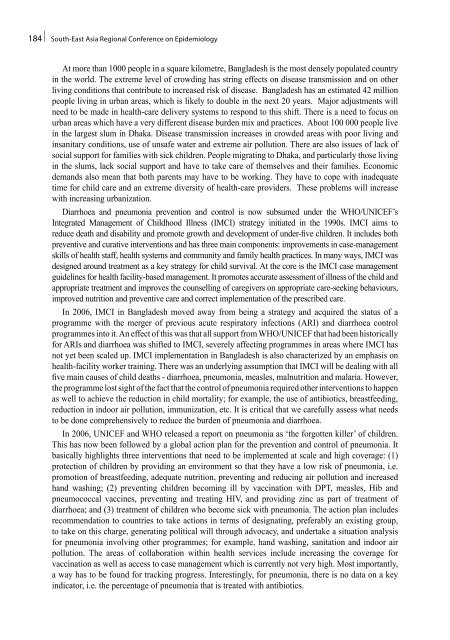South-East Asia Regional Conference on Epidemiology
South-East Asia Regional Conference on Epidemiology
South-East Asia Regional Conference on Epidemiology
Create successful ePaper yourself
Turn your PDF publications into a flip-book with our unique Google optimized e-Paper software.
184 | <str<strong>on</strong>g>South</str<strong>on</strong>g>-<str<strong>on</strong>g>East</str<strong>on</strong>g> <str<strong>on</strong>g>Asia</str<strong>on</strong>g> <str<strong>on</strong>g>Regi<strong>on</strong>al</str<strong>on</strong>g> <str<strong>on</strong>g>C<strong>on</strong>ference</str<strong>on</strong>g> <strong>on</strong> <strong>Epidemiology</strong><br />
At more than 1000 people in a square kilometre, Bangladesh is the most densely populated country<br />
in the world. The extreme level of crowding has string effects <strong>on</strong> disease transmissi<strong>on</strong> and <strong>on</strong> other<br />
living c<strong>on</strong>diti<strong>on</strong>s that c<strong>on</strong>tribute to increased risk of disease. Bangladesh has an estimated 42 milli<strong>on</strong><br />
people living in urban areas, which is likely to double in the next 20 years. Major adjustments will<br />
need to be made in health-care delivery systems to resp<strong>on</strong>d to this shift. There is a need to focus <strong>on</strong><br />
urban areas which have a very different disease burden mix and practices. About 100 000 people live<br />
in the largest slum in Dhaka. Disease transmissi<strong>on</strong> increases in crowded areas with poor living and<br />
insanitary c<strong>on</strong>diti<strong>on</strong>s, use of unsafe water and extreme air polluti<strong>on</strong>. There are also issues of lack of<br />
social support for families with sick children. People migrating to Dhaka, and particularly those living<br />
in the slums, lack social support and have to take care of themselves and their families. Ec<strong>on</strong>omic<br />
demands also mean that both parents may have to be working. They have to cope with inadequate<br />
time for child care and an extreme diversity of health-care providers. These problems will increase<br />
with increasing urbanizati<strong>on</strong>.<br />
Diarrhoea and pneum<strong>on</strong>ia preventi<strong>on</strong> and c<strong>on</strong>trol is now subsumed under the WHO/UNICEF’s<br />
Integrated Management of Childhood Illness (IMCI) strategy initiated in the 1990s. IMCI aims to<br />
reduce death and disability and promote growth and development of under-five children. It includes both<br />
preventive and curative interventi<strong>on</strong>s and has three main comp<strong>on</strong>ents: improvements in case-management<br />
skills of health staff, health systems and community and family health practices. In many ways, IMCI was<br />
designed around treatment as a key strategy for child survival. At the core is the IMCI case management<br />
guidelines for health facility-based management. It promotes accurate assessment of illness of the child and<br />
appropriate treatment and improves the counselling of caregivers <strong>on</strong> appropriate care-seeking behaviours,<br />
improved nutriti<strong>on</strong> and preventive care and correct implementati<strong>on</strong> of the prescribed care.<br />
In 2006, IMCI in Bangladesh moved away from being a strategy and acquired the status of a<br />
programme with the merger of previous acute respiratory infecti<strong>on</strong>s (ARI) and diarrhoea c<strong>on</strong>trol<br />
programmes into it. An effect of this was that all support from WHO/UNICEF that had been historically<br />
for ARIs and diarrhoea was shifted to IMCI, severely affecting programmes in areas where IMCI has<br />
not yet been scaled up. IMCI implementati<strong>on</strong> in Bangladesh is also characterized by an emphasis <strong>on</strong><br />
health-facility worker training. There was an underlying assumpti<strong>on</strong> that IMCI will be dealing with all<br />
five main causes of child deaths - diarrhoea, pneum<strong>on</strong>ia, measles, malnutriti<strong>on</strong> and malaria. However,<br />
the programme lost sight of the fact that the c<strong>on</strong>trol of pneum<strong>on</strong>ia required other interventi<strong>on</strong>s to happen<br />
as well to achieve the reducti<strong>on</strong> in child mortality; for example, the use of antibiotics, breastfeeding,<br />
reducti<strong>on</strong> in indoor air polluti<strong>on</strong>, immunizati<strong>on</strong>, etc. It is critical that we carefully assess what needs<br />
to be d<strong>on</strong>e comprehensively to reduce the burden of pneum<strong>on</strong>ia and diarrhoea.<br />
In 2006, UNICEF and WHO released a report <strong>on</strong> pneum<strong>on</strong>ia as ‘the forgotten killer’ of children.<br />
This has now been followed by a global acti<strong>on</strong> plan for the preventi<strong>on</strong> and c<strong>on</strong>trol of pneum<strong>on</strong>ia. It<br />
basically highlights three interventi<strong>on</strong>s that need to be implemented at scale and high coverage: (1)<br />
protecti<strong>on</strong> of children by providing an envir<strong>on</strong>ment so that they have a low risk of pneum<strong>on</strong>ia, i.e.<br />
promoti<strong>on</strong> of breastfeeding, adequate nutriti<strong>on</strong>, preventing and reducing air polluti<strong>on</strong> and increased<br />
hand washing; (2) preventing children becoming ill by vaccinati<strong>on</strong> with DPT, measles, Hib and<br />
pneumococcal vaccines, preventing and treating HIV, and providing zinc as part of treatment of<br />
diarrhoea; and (3) treatment of children who become sick with pneum<strong>on</strong>ia. The acti<strong>on</strong> plan includes<br />
recommendati<strong>on</strong> to countries to take acti<strong>on</strong>s in terms of designating, preferably an existing group,<br />
to take <strong>on</strong> this charge, generating political will through advocacy, and undertake a situati<strong>on</strong> analysis<br />
for pneum<strong>on</strong>ia involving other programmes; for example, hand washing, sanitati<strong>on</strong> and indoor air<br />
polluti<strong>on</strong>. The areas of collaborati<strong>on</strong> within health services include increasing the coverage for<br />
vaccinati<strong>on</strong> as well as access to case management which is currently not very high. Most importantly,<br />
a way has to be found for tracking progress. Interestingly, for pneum<strong>on</strong>ia, there is no data <strong>on</strong> a key<br />
indicator, i.e. the percentage of pneum<strong>on</strong>ia that is treated with antibiotics.









